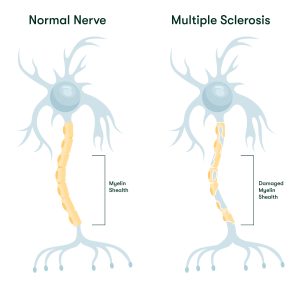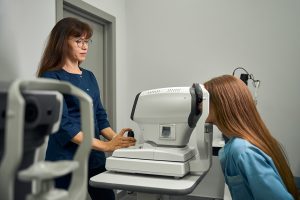This blog is designed to provide information about Multiple Sclerosis (MS) for those living with this condition, their caregivers, loved ones, and anyone interested in learning about this disease. Here, you’ll find information about what Multiple Sclerosis is, how it is diagnosed, the symptoms, the available therapies, and ongoing research into investigational treatments.
Multiple Sclerosis (MS) is a neurological disorder caused by an autoimmune response that affects the central nervous system. It occurs when the body’s immune system mistakenly attacks and destroys the myelin sheath — the protective layer surrounding the nerves, including those in the brain, optic nerve and spinal cord. Without this protective covering, nerve fibers become exposed, slowing down or blocking the signals being transmitted within them — similar to a frayed wire that can’t carry electricity properly. 1, 2
The body attempts to repair the damaged myelin but often leaves lesions or scars (also called plaques), which can disrupt nerve signals even more. 2 Over time, if the myelin damage and scars persist, the underlying nerve fibers may also become damaged or die, leading to long-term issues such as worsening mobility or vision. 2
Worldwide, Multiple Sclerosis affects over 2.9 million people, with at least 300 new cases diagnosed each year. 3

The direct cause of Multiple Sclerosis is the body’s immune system mistakenly attacking the myelin sheath. However, the underlying reasons why the immune system behaves this way remain unknown.
However, the risk of developing this condition may be increased by several genetics and environmental factors, such as: 2, 4
Other factors that may be associated with an increased risk of developing Multiple Sclerosis include low vitamin D levels, obesity, smoking, and differences in the gut microbiome — the community of bacteria in the digestive system. 2, 4
Early symptoms of Multiple Sclerosis can differ widely from person to person, depending on the location and severity of nerve damage in the nervous system. 2, 8 Some of the most common symptoms of Multiple Sclerosis include: 8
Symptoms may appear (called “flare-ups” or “relapses”) and disappear afterwards (called “remissions”) and potentially worsen over time.8 Multiple Sclerosis can be classified into different types based on how the disease progresses and how often relapses occur. These Multiple Sclerosis types include relapsing-remitting multiple sclerosis (RRMS), primary progressive multiple sclerosis (PPMS), and secondary progressive multiple sclerosis (SPMS). 2, 8 Other conditions that are related to Multiple Sclerosis include clinically isolated syndrome (CIS) and radiologically isolated syndrome (RIS), as people with these conditions may developed Multiple Sclerosis in the future. 9, 10, 11, 12
This blog focuses on Multiple Sclerosis in general and will not cover this classification or related conditions.
There is no specific test to diagnose Multiple Sclerosis. Instead, physicians use a combination of medical history, physical exams, imaging tests, and other assessments to make the diagnosis and rule out other conditions that might produce similar symptoms. 2 These include:
– Magnetic resonance imaging (MRI): An MRI uses radio waves and strong magnetic fields to produce detailed images of the brain and spinal cord. This technique can detect lesions or scars in the nerve fibers that could be caused by multiple sclerosis. 2, 13
– Lumbar puncture: Commonly known as spinal tap, it is a procedure where a small sample of cerebrospinal fluid is taken from the spinal canal and tested in a lab. This sample can show changes in antibodies — proteins made by the immune system to fight infections — linked to Multiple Sclerosis. 2, 13
– Optical coherence tomography: This method uses light waves to generate images of the eye. It can detect signs of optic neuritis, an inflammation of the optic nerve connecting the eye to the brain, which is common in Multiple Sclerosis. 2, 13
– Evoked potential tests: These tests measure how quickly the nerves respond to signals. For example, a person may watch a moving visual pattern or receive mild electrical stimulation on the arms or legs. Electrodes placed on the skin track how fast these signals travel through the nerve pathways. 2, 10
Other tests may include blood analysis to rule out diseases with symptoms similar to Multiple Sclerosis, or neuropsychological testing to assess memory, thinking skills, or mood, as these can be affected in individuals with Multiple Sclerosis. 2

While there is no cure for Multiple Sclerosis, therapies focus on speeding recovery from flare-ups (relapses), slowing disease progression (disease-modifying therapies) and reducing symptoms. 2 Treatment options for Multiple Sclerosis include:
These short-term treatments are designed to help people recover more quickly and feel better during a relapse (when symptoms suddenly worsen). However, they do not stop relapses from happening again in the future.
The most common treatment is corticosteroids, such as oral prednisone or intravenous methylprednisolone, to help reduce inflammation and speed up recovery during flare-ups.13 For severe cases that do not respond to corticosteroids, plasma exchange may be considered. This procedure removes the liquid part of the blood (plasma), which may contain harmful immune proteins attacking myelin, and replaces it with a special fluid. 2, 13
These are long-term treatments designed to reduce the activity of the disease, slow its progression, and prevent relapses.2 There are around 20 medications approved by the European Medicine Agency and Food and Drug Administration as disease-modifying treatments for Multiple Sclerosis. All these Multiple Sclerosis treatments are immunotherapies, meaning they work by regulating the immune system to reduce its attacks on the central nervous system.
Some of these treatments include:
For a complete list of these medicines, please see Table 1.
These therapies focus on relieving the physical and emotional challenges of Multiple Sclerosis to improve daily life. These Multiple Sclerosis treatments may include:

Research in Multiple Sclerosis is advancing in several key areas, with investigational treatments focusing on:
Here’s an overview of some investigational therapies for Multiple Sclerosis being explored in clinical trials:
In addition to the already approved immunotherapies for treating Multiple Sclerosis, researchers are studying new immunotherapies aimed at better regulating or suppressing the immune system’s harmful response. By targeting specific components of the immune system, these therapies seek to reduce relapses and slow disease progression. Some of these investigational treatments for Multiple Sclerosis are currently being tested in clinical trials to determine their safety and effectiveness. 17
Along with treatments that aim to stop immune system attacks, researchers are exploring therapies to repair the myelin sheath, the protective coating around nerves damaged by Multiple Sclerosis. 13, 14 These treatments aim to stimulate the body’s natural repair mechanisms, encouraging the production of new myelin to replace damaged areas. Some of the medications being studied in clinical trials include allergy medications (antihistamines), hormone-related drugs, vitamin A derivatives and special antibodies. 13, 14
Stem cells are special cells in the body that have unique abilities, such as, under certain circumstances, the capacity to transform into different types of cells, like muscle or brain cells. In the field of Multiple Sclerosis, stem cells are being studied for their possible role in addressing various aspects of the disease, including: 18
Currently, researchers are studying these three aspects to understand its effects, safety, and potential role in Multiple Sclerosis care. 19
Multiple Sclerosis (MS) is a neurological condition in which the body’s immune system attacks and destroys the protective covering of the nerves in the brain, optic nerve and spinal cord. While there is currently no cure for Multiple Sclerosis, existing treatments focus on three main goals: managing relapses (using medications such as interferon), slowing disease progression (with different injectable, oral or infused medications), and addressing symptoms (for example with physical therapy). Ongoing research in clinical trials is focused on advancing in several key areas, including developing new immunotherapies to prevent immune system attacks, repairing existing damage by rebuilding the protective coating around nerves, and using stem cells to support multiple processes, such as nerve repair and immune system regulation. While these approaches are being actively studied, further clinical trials are needed to confirm their safety and effectiveness.
Table 1. Disease-Modifying Therapies (DMTs) Approved by the FDA and EMA as of December 24, 2024
To the best of our knowledge, the following medications have been approved by both the U.S. Food and Drug Administration (FDA) and the European Medicines Agency (EMA) for the treatment of multiple sclerosis (MS). 14, 20, 21, 22, 23
|
Medication |
Brand name |
Administration |
|
| FDA/United States | EMA/European Union | ||
| Interferon beta-1a | Avonex®/Rebif® | Avonex®/Rebif® | Injection |
| Interferon beta-1b | Betaseron®/Extavia® | Betaferon®/Extavia® | Injection |
| Pegylated interferon beta-1a | Plegridy® | Plegridy® | Injection |
| Glatiramer acetate | Copaxone®/Glatopa® | Copaxone® | Injection |
| Ofatumumab | Kesimpta® | Kesimpta® | Injection |
| Ocrelizumab/hyaluronidase | Ocrevus Zunovo™ | Ocrevus Zunovo™ | Injection |
| Fingolimod | Gilenya® | Gilenya® | Oral |
| Teriflunomide | Aubagio® | Aubagio® | Oral |
| Dimethyl fumarate | Tecfidera® | Tecfidera® | Oral |
| Monomethyl fumarate | Bafiertam™ | not approved | Oral |
| Diroximel fumarate | Vumerity® | Vumerity® | Oral |
| Siponimod | Mayzent® | Mayzent® | Oral |
| Cladribine | Mavenclad® | Mavenclad® | Oral |
| Ozanimod | Zeposia® | Zeposia® | Oral |
| Ponesimod | Ponvory™ | Ponvory™ | Oral |
| Ublituximab | Briumvi® | Briumvi® | Infusion |
| Natalizumab | Tysabri® | Tysabri® | Infusion |
| Mitoxantrone | Novantrone® | Novantrone® | Infusion |
| Alemtuzumab | Lemtrada® | Lemtrada® | Infusion |
| Ocrelizumab | Ocrevus® | Ocrevus® | Infusion |
If you are affected by Multiple Sclerosis (MS) and want to explore clinical trial options, you can book a call with a Patient Navigator to discuss your options and learn more about participating in clinical trials.
At myTomorrows, we have a team of Patient Navigators, who are multi-lingual professionals with a medical background, who can help you to explore your treatment options and support you through your journey.
myTomorrows Team 6 Mar 2025